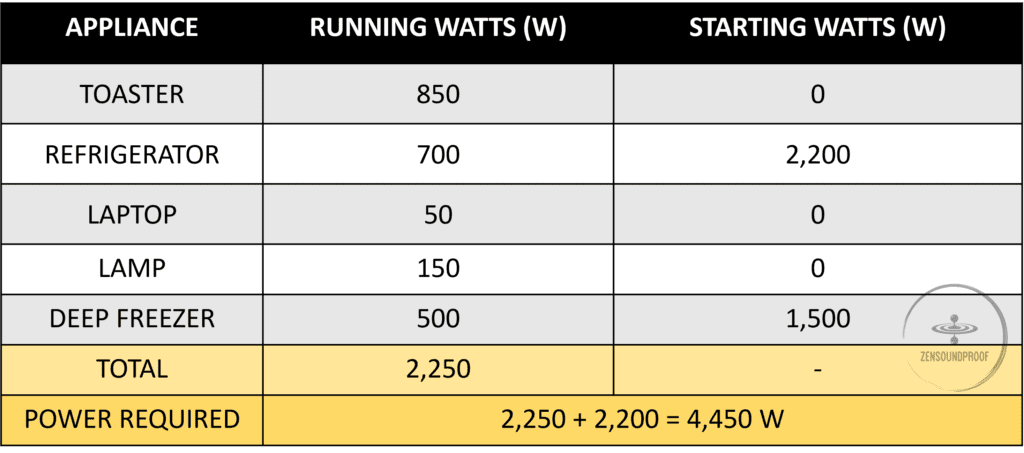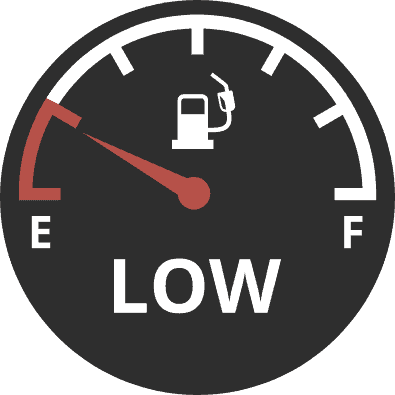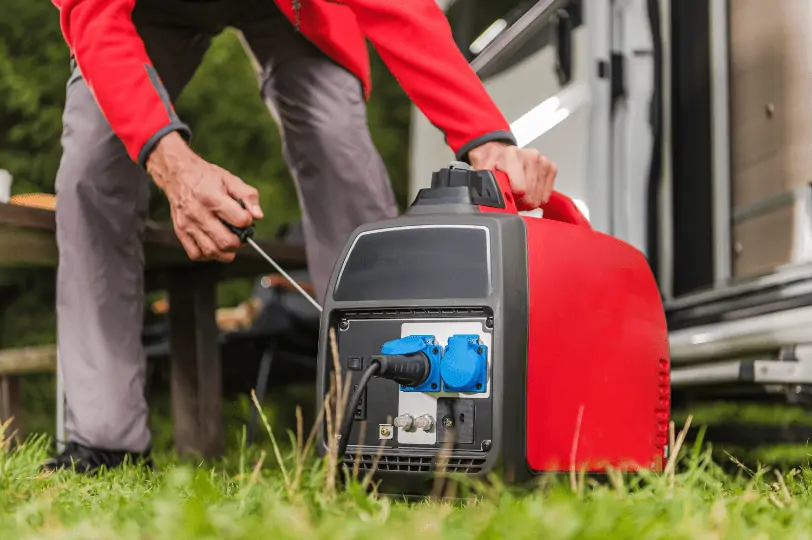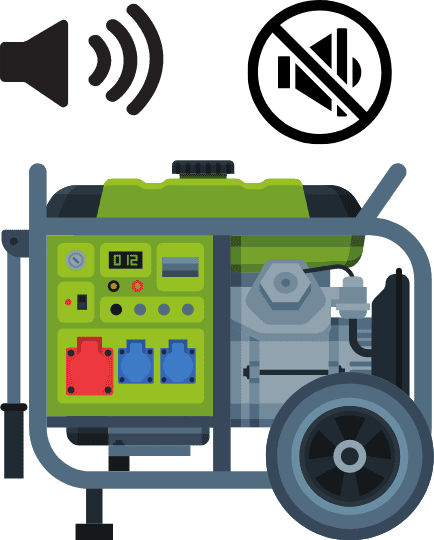A quiet generator 5000 watt is useful for keeping around the home – or to take camping. Although not the most powerful type of generator you can buy, 5000 watts is just enough for a home’s backup power.
Whether you’re taking it camping or using at home, you’ll want it to be quiet. So, in this article, I cover my top picks for the quietest 5000 watt generator. First, let’s discuss what we actually mean by quiet.
Additionally, consider checking out these additional resources if you need different power output:
- My list of the quietest 4000 Watt generators.
- My list of the quietest 7000 Watt generators.
- My list of the quietest 10,000 Watt generators.
- My list of the quietest generators for camping, home backup, or RVing.
How Loud Should a 5000 Watt Generator Be?
A 5000 watt generator should ideally be quieter than 75dB. Some models will get as quiet as 50dB when working at lower load capacities. For context, this is a noise range of roughly the sound of a quiet office to the sound of a vacuum cleaner.
Of course, there are numerous variables that impact a generator’s noise level. These include build quality, working capacity, and power level. If you think you can get away with a less powerful generator, consider looking at a 4000W model because it’ll be slightly quieter.
In my reviews below, I consider these important factors when picking out the quietest generators. Of course, noise level will be the most important.
Our Top 7 Picks
So, let’s go over some of the best picks for 5000 watt portable inverter generator currently on the market. Bear in mind you might pay slightly more for a quieter model, but I definitely think it’s worth it.
Top Pick: GENMAX 5500W Portable Generator
- Noise level: 63 dB min
- Starting Power: 5500 W
- Running Power: 5000 W
- Inverter: Yes
- Start: Electric & Recoil
- Dual fuel: No
- Run time: 8.5 hours (50% load)
- Tank capacity: 3.6 gal
- Outlet / Port:
4 x 120V 5-20R [20A] – (Household type)
1 x 120/240V L14-30R [30A]
1 x 5V USB
- Wheels: Yes
- Handle: Yes (Extendable)
- Weight: 127.5 lbs.
The GENMAX 5500W is my top pick because, at 63dB, it’s by far the quietest on this list. It has a surge wattage of 5500W and a running wattage of 5000W. While this is slightly lower than other picks below, it’s more than compensated for by the lower noise rating.
It has a 3.6-gallon fuel tank, which provides up to 10 hours of runtime on quarter load. At half load, this drops to around 8.5 hours. Either way, it’s generally enough to keep you going overnight.
The generator has both manual and electric starts and a good range of outlets. It includes 4 x 120V, a 120/240V, and a 5V. Although others have a 12V battery charging outlet, it’s not the end of the world that there isn’t one here.
There are two downsides to this generator. The main is that the oil tank arrives empty out of the box. You’ll have to fill it before kicking in the motor. You can use some 10W-30. The second downside is the product doesn’t include an RV 30A locking plug. If you plan on connecting to your RV, you should consider buying one separately, like this one.
- Noise level of 63dB.
- Up to 10 hours runtime.
- Plenty of outlets.
- Doesn’t come with oil out of the box.
- No 30A RV plug included.
Top Budget Pick: WEN GN6000 Portable Generator
- Noise level: 68 dB min
- Starting Power: 6000 W
- Running Power: 5500 W
- Inverter: No
- Start: Electric & Recoil
- Dual fuel: No
- Run time: 7.5 hours (50% load)
- Tank capacity: 3.4 gal
- Outlet / Port:
2 x 120V 5-20R [20A] – (Household type)
1 x 120V TT-30R [30A]
1 x 120/240V L14-30R [30A] – (RV type)
1 x 12V Automotive
- Wheels: Yes
- Handle: Yes (Foldable)
- Weight: 129.7 lbs.
If you’re after a budget-friendly generator, the WEN GN6000 could be a good pick for you. It’s got a slightly higher surge wattage than the GENMAX model (6000 rather than 5500), but its running power output is the same.
One area where the price difference is really noticeable is in its fuel capacity. The tank is 3.4 gallons, which equates to a maximum runtime of 7.5 hours. This does make a difference in pretty much every scenario, although it only translates to filling the tank up more often.
Its noise level is 68dB, which is way above the GENMAX above but roughly the same as the Champion below. For a budget model, this isn’t too bad. At 129.7 lbs., the WEN is 2% heavier than the GENMAX above. But they both have roughly the same portability thanks to the included wheel kit and folding handle.
You’ll find 2 x 120V outlets, a 30A, a 120/240V outlet and a 12V. This is another area where the price difference becomes noticeable: it has 2 fewer standard outlets than the well-equipped Champion below. That said, 2 normal outlets are fine in most situations.
In terms of downsides, the biggest is that many users complained about receiving the generator with broken parts. The manufacturer seems to overlook quality control. Fortunately, even though not ideal, most could figure it out with the customer support.
- 68dB operating noise.
- Ultra competitive price.
- Enough outlets for most situations.
- Easy to move around.
- Lacks quality control.
3. Champion Power Equipment 100519 6250-Watt Generator
- Noise level: 69 dB min
- Starting Power: 6250 W
- Running Power: 5000 W
- Inverter: Yes
- Start: Electric & Recoil
- Dual fuel: No
- Run time: 13.5 hours (50% load)
- Tank capacity: 4.2 gal
- Outlet / Port:
4 x 120V 5-20R [20A] – (Household type)
1 x 120/240V L14-30R [30A]
1 x 12V Automotive
- Wheels: Yes
- Handle: Yes (Foldable)
- Weight: 121 lbs.
The Champion 100519 has a starting wattage of 6250 but a running wattage of 5000. At 69dB operating noise level, it’s certainly not the quietest generator on the market. However, its features make up for this.
The competitiveness of the package is certainly why it’s the most popular generator on this list.
First, it’s got a 4.2 gallon fuel tank, which gives you up to 13.5 hours of runtime. There’s also an eco-mode, which increases runtime. In short, eco-mode brings the generator’s idle down. As soon as it needs power, eco-mode shuts off, but there’s no change in wattage output. For example, if you were running an AC and it turned off, eco-mode would kick in. The goal is to increase fuel efficiency, which is useful when you’re out camping.
In terms of outlets, it’s got 4 x 120V, a 120/240V outlet, a 12V, and a 5V USB adapter. The 240V outlet is useful because it means you can run more demanding appliances, such as an RV HVAC unit or similar.
Although it weighs 121lbs., transport is comparatively easy. There are wheels and a foldaway handle, so you can just push it around rather than lifting it. Another useful feature is the cold start technology, which, unsurprisingly, makes it much easier to start in cold weather.
Some users state that it can be difficult to start the generator in eco-mode. This is generally because it can’t draw enough starting power, so just make sure it’s in normal mode and it should start first time.
- Plenty of outlets.
- Good runtime.
- Easy to transport.
- It can be difficult to start in eco-mode.
4. Westinghouse WGen5300s Portable Inverter Generator
- Noise level: 68 dB min
- Starting Power: 6600 W
- Running Power: 5300 W
- Inverter: No
- Start: Electric & Recoil
- Dual fuel: No
- Run time: 11 hours (50% load)
- Tank capacity: 4.7 gal
- Outlet / Port:
1 x 120V 5-20R [20A] – (Household type)
1 x 120/240V L14-30R [30A]
1 x 120V TT-30R [30A] – (RV type)
- Wheels: Yes
- Handle: Yes (Foldable)
- Weight: 131.4 lbs.
The Westinghouse WGen5300s has a peak wattage of 6600 and a running wattage of 5300. Its operating noise level is 68dB, which is about average for a 5000 watt generator.
It runs on gasoline only, and its 4.7 gallon tank gives you a maximum runtime of 14.5 hours on quarter load. If you want a longer runtime and aren’t as bothered about noise levels, the older Westinghouse WGen5500 could be a good option. It gives you up to 20 hours of runtime but operates at 72dB.
The WGen5300s has 2 x 120V outlets, a 30A 120V outlet, and a 120/240V outlet. It’s got fewer options than the Champion above, but you’re covered for the main options. A 12V outlet is useful for some situations, but it’s not a complete necessity for a backup home generator.
This generator features an electric start switch and manual choke, making it pretty easy to start. For a bit less money, you can get the WGen5300v, which is only a recoil cord. However, the extra cost is arguably worth it to not throw your back out every time!
Some users mention that it’s a bit difficult to transport. It’s 131 lbs., so is 8% heavier than the Champion and the heaviest on the list. On the bright side, it does come on wheels, and with a handle.
- 14.5 hour runtime.
- Good noise/power ratio.
- Electric start switch.
- Not super easy to move around.
5. DuroMax XP5500EH Dual Fuel Generator
- Noise level: 69 dB min
- Starting Power: 5500/5225 W (gasoline/propane)
- Running Power: 4500/4275 W (gasoline/propane)
- Inverter: No
- Start: Electric & Recoil
- Dual fuel: Yes
- Run time:
On gasoline, 9 hours (50% load)
On propane, 8 hours (50% load) - Tank capacity: 4.7 gal
- Outlet / Port:
2 x 120V 5-20R [20A] – (Household type)
1 x 120/240V L14-30R [30A]
1 x 12V Post
- Wheels: Yes
- Handle: Yes (Foldable)
- Weight: 124 lbs.
At 69dB, the DuroMax XP5500EH has the same noise level as the Champion model above. Its running wattage is the lowest on this list (4500 watts), so it’s on the lower end of the 5000 watt generator scale.
However, its main selling point is that it’s a dual fuel generator. In short, this means it can run on either gasoline or propane. Dual fuel gives you greater flexibility if you’re not transporting the generator because a propane tank can run it for much longer than gasoline can.
Another big difference is that you can run both 120V and 240V simultaneously on this generator. Most only let you run either, so this is helpful if you’ve got several devices to power at once. Its outlets are 2 x 120V and a 120/240V 30A. There’s also a 12V charging port for batteries.
The generator weighs 124lbs., which is about average for a 5000 watt generator. Importantly, it comes with wheels and a folding handle, making it easy to transport. It might sound like a minor feature, but you’ll notice the difference if you ever need to try and carry a generator!
Its major downside is that, when running on propane, its running wattage is 4275. This is standard for propane-powered generators, but it’s worth point out in case you expected 4500W all the time. Another downside, minor this time, is that it doesn’t come with a RV-type outlet TT-30R. Even if adapters are not expensive, it would have been a welcome addition.
- Dual fuel generator.
- Easy to transport.
- It runs 120V and 240V at the same time.
- Running watts are lower when using propane.
- Noise level is average in this category.
- No 30A RV-type outlet.
6. Briggs & Stratton S5500 Portable Generator
- Noise level: NC
- Starting Power: 6875 W
- Running Power: 5500 W
- Inverter: No
- Start: Recoil
- Dual fuel: No
- Run time: 12 hours (50% load)
- Tank capacity: 7.5 gal
- Outlet / Port:
4 x 120V 5-20R [20A] – (Household type)
1 x 120/240V L14-30R [30A]
- Wheels: Yes
- Handle: Yes (Foldable)
- Weight: 190 lbs.
Unfortunately, the Briggs & Stratton S5500 doesn’t come with a specific decibel rating. However, it’s rated fairly well in user reviews on noise level, so we can assume it’s not too dissimilar from the other 5000 watt generators on this list.
It has a 7-gallon fuel tank capacity, which is much larger than the other generators on this list. However, its maximum runtime is still 12.5 hours because it has a more powerful engine (389cc), meaning it’s clearly not the most energy efficient.
It has 4 x 120V outlets and a 120/240V 30A. There’s also a power surge alternator for starting machinery or large appliances. The surge power can reach an impressive 6875W. It’s almost 7000W!
The generator comes with a wheel kit and handle for easy mobility. Better yet, the wheels are hard rubber rather than inflated, so you don’t have to worry about them bursting if you’re transporting it over rough ground.
Worth mentioning that at 190 lbs. (its specs don’t mention if it’s dry or wet weight), it’s the heaviest unit we reviewed so far. The main culprit is its huge gas tank capacity.
Its main downside is that it uses a recoil cord starter. Again, this isn’t a massive issue, but it’s definitely more inconvenient than an electric switch.
- Massive autonomy thanks to a 7-gallon fuel tank.
- 4 x 120V outlets.
- Starting watts close to the 7000 W range.
- No electric starter switch.
- Very heavy.
- No 30A RV-type outelt.
7. Briggs & Stratton Q6500 Inverter Generator
- Noise level: 66 dB min
- Starting Power: 6500 W
- Running Power: 5000 W
- Inverter: Yes
- Start: Recoil
- Dual fuel: No
- Run time: 14 hours (25% load)
- Tank capacity: 5 gal
- Outlet / Port:
4 x 120V 5-20R [20A] – (Household type)
1 x 120/240V L14-30R [30A]
2 x 5V USB
- Wheels: Yes
- Handle: Yes (Extendable)
- Weight: 127.9 lbs.
The Briggs & Stratton Q6500 is part of the company’s Quiet Series range. To reduce noise, it’s enclosed in a protective shell that also weatherproofs the engine. The company claims it’s more than 60% quieter than standard generators.
However, at 66dB, it’s not drastically quieter than almost every other entry on this list. Granted, it is the second quietest, but there are several factors that mean it wasn’t in the running for top pick.
First, it doesn’t have an electric starter. Considering that most generators at this price range feature one, it’s a big downside. Also, the motor is 306cc (whereas the GENMAX is 312cc), yet the starting wattage of the Briggs & Stratton is superior by 1000 W. Running wattage is the same though. In short, there doesn’t appear to be much reason why the engine is more powerful on this Briggs & Stratton.
In terms of weight, it’s 127.9 lbs., so it’s right on the average of a 5000 Watt generator.
Its runtime is 14 hours (25% load), which is just one hour more than our Top Pick the GENMAX.
It has the standard outlets you’d expect from a 5000 watt generator. There are 4 x 120V, a 120/240V, and 2 x USB outlets. If it had a 12V outlet, it would definitely be in the running for top spot, but it’s also not a necessity in all situations.
Some users state that the transport handle is a bit flimsy for the size and weight of the generator. Another feedback from users is that the unit doesn’t seem too stable when under load. It tends to vibrate as if the generator was too light.
- 2nd quietest on this list at 66dB.
- Enclosed generator.
- Solid runtime with 14 hours.
- Transport handle isn’t sturdy enough for the weight.
- Jumps and vibrates under load.
- No electric starter.
What Features Matter
While noise level is our main concern here, it’s obviously not the only thing to consider when buying a generator. So, here are the main factors to think about when making your pick.
Power Level
5000 watt power generators are enough for a camping holiday or RV. At a stretch, you could use it as backup for a home during a power outage, providing you’re careful with what you decide to power and for how long.
Unsurprisingly, a 5000W generator can output a maximum of 5000 watts at any given time. But what does this mean in real terms?
As you probably know, watts are a measure of power factoring in the voltage (V) and current (Amps). Every electronic device in your home (or RV) will have a running wattage of power consumption. When deciding if a 5000 watt generator is enough for your needs, you need to calculate the maximum required wattage at any given time.
To do this, you add up all the running watt values of your devices and then add the highest surge wattage. Refer to this list for a guide of power demands for standard household devices.
This table gives you a rough idea of what this means.

As you can see, a 5000 watt generator would be enough to power all these devices at once. Also, it should highlight that 5000 watts doesn’t get you all that far, considering this is only 5 appliances. On the other hand, it’d be fine for using at a jobsite to run heavy duty power tools.
Running Watts vs. Surge Watts
We also need to understand what we mean by running watts and surge (or starting watts). In short, these are:
- Starting watts is a measurement of how much power the device needs to get going. Motor-driven devices (such as a refrigerator) need extra starting power to kick them into gear.
- Running watts is a measurement of how much power the device consumes over a sustained period. Think of this as its normal operating level.
Starting watts might not be as important when you’re camping, depending on what devices you’ve brought. However, for backup home power or an RV, it’s important because you’ll likely be running things like a refrigerator and oven.
A 5000 watt generator can have a starting wattage of 6000 watts or more. This is the level of power it can generate for a short period to start these devices. Just keep an eye out for the numbers listed to make sure you’re buying one that’s powerful enough.
Runtime and Fuel Tank Capacity

Runtime is fairly self-explanatory. It’s a measurement of how long the generator can run on a full tank of gas. The runtimes given by manufacturers are usually at quarter or half load, as these are the highest values.
Load is a measurement of power demands. For example, a 5000 watt generator running at quarter load will be producing 1250 watts of power.
There’s not really a correct answer for best runtime, as it simply translates to how often you’ll need to fill the gas tank. That said, anything over 12 hours is preferable, as it means you can go to sleep without worrying about your generator running out of fuel.
Unsurprisingly, runtime is related to fuel tank size, along with factors like engine size and fuel efficiency. Generally, a fuel efficient generator should get 10-12 hours of runtime off a fuel tank of between 3 and 4 gallons.
Inverter Generator
An inverter generator is one that produces cleaner power. By this, I mean that there’s less harmonic distortion. Without getting into too much detail, this is preferable for devices that contain chips and microprocessors because it reduces the risk of damage. Sometimes it won’t go as far as damages, as it will simply not recognize your connected device.
A generator can produce power with fluctuating voltages and frequencies due to the engine running at varying RPMs. This is harmonic distortion. An inverter generator, however, throttles the engine to keep it running consistently.
In short, it’s a more efficient and reliable source of power. While they’re slightly more expensive than conventional generators, it’s arguably worth it in the long run. If nothing else, you don’t run the same risk of damaging your electronic devices.
I’ve indicated on the list above which is an inverter and which is not. Hopefully, it’ll help you make an informed decision according to your needs.
Starter Type

Generators will either have electric or manual starters. An electric starter is essentially a switch that uses a battery to power an electric motor that then cranks the engine. On the other hand, a manual starter uses a recoil cord that you pull to start the engine.
Electric starters are more expensive, but are definitely worth the money. A recoil cord is by default more reliable because it’s one less thing to go wrong. However, almost all electric starter generators will have a manual starter included, too.
Noise Level

There’s not much else to say about noise level, apart from the fact that manufacturers generally state the dB ratings in their product’s specification. Noise is relative to your needs and what you consider to be acceptable. But, as you can see, most 5000 watt generators sit around 68dB.
If you want something quieter, I suggest a 4000 watt generator. In my list of top picks, you’ll find ones as quiet as 52dB.
However, if you need the extra power, consider looking at ways to quieten your 5000W generator.
There are also quiet 7000-watt and 10000-watt generators, but they’ll obviously be noisier than a 5000-watt unit.
Outlets

Outlets are one of the more important features, considering you’re using a generator to power devices! At the very least, you’ll get a 120V, 20A standard outlet (designation: Nema 5-20R). This is equivalent to mains electricity, so is fine for almost all devices. Ideally, look for a generator that has 2, but 4 or more give you greater flexibility.
Additionally, you can find 120V, 30A RV outlets. They are meant to connect to supply power to an RV. These outlets are referenced as Nema TT-30R.
Generators also come with a 120/240V outlet, which is for devices that consume more power. For example, this could be an AC unit or a water pump. These outlets are rated at 30A and they are referred to as L14-30R.
Note that most generators won’t let you run both 120V and 240V devices at the same time. Some will, though, so keep an eye out for this if you think it’ll be important.
Other outlets include:
- 5V USB outlets (for phones, tablets, etc.)
- 12V car-style outlets for batteries etc.
These last ones aren’t super necessary, as there are other ways to charge these devices. However, if you’re buying a generator for a jobsite and want to charge your tools, a 12V outlet would be useful.
Portability
A portable generator should be portable. Most of the entries on this list come with wheels and handles, which is enough to pull it around. Considering some weigh up to 140lbs., you’ll want an easier option than carrying it!
Of course, weight will be important for going camping. There’s a difference between a technically portable generator and one that’s easy to transport. The lightest 5000 watt generators are around 100lbs.
Extra Features
Some extra features that can improve the functionality of your generator include:
- Weatherproof outlet covers
- Digital screen for monitoring power consumption, remaining runtime, etc.
- Dual fuel – allows you to run the generator off propane
- Low oil shutoff – prevents damage to a gas powered generator if it runs low on oil
- Fuel gauge for obvious reasons
Also, a CO monitor and shutoff system is pretty useful. It turns the generator off if it detects high levels of carbon monoxide. However, if you’re running the generator outside (as is recommended), this shouldn’t be a problem unless it malfunctions.
Warranty
Finally, consider the length of the warranty on your generator. A 3-year warranty is fairly standard, although some will offer 5 years or more.
Considering generators are fairly expensive and aren’t something you run all the time, a longer warranty is usually better. After all, if you only use it for a few weeks of the year, you’ll want to make sure you’re covered for the longest time possible.
Final Thoughts
I hope you’ve now got enough information to pick out the best quiet 5000 watt generator for your needs.
My top pick is the GENMAX 5500W Generator. It’s the quietest generator on this list and has all the features you need for pretty much any situation.
Of course, any of the other generators on this list will be a good choice.
Do you have any other recommendations for efficient (and quiet) 5000 watt generators? Let me know below.







